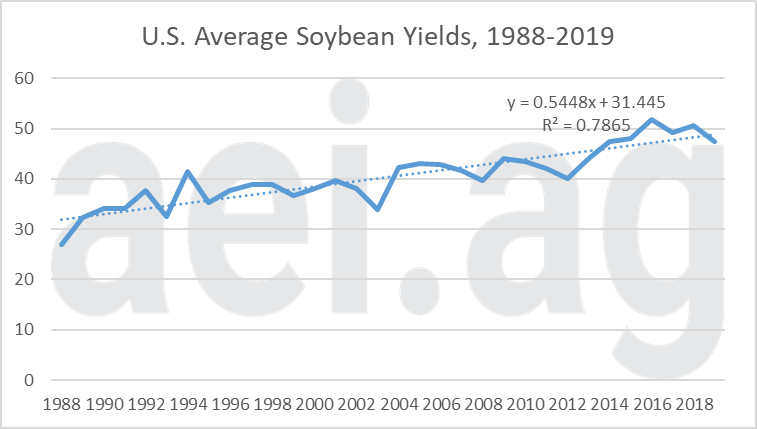The 2020 Soybean Yield Guide
Following-up on the 2020 Corn Yield Guide, this week’s post, the Soybean Yield Guide, considers historic soybean yield data and what 2020 might have in store.
Background
Similar to corn, the USDA’s May WASDE report was the first estimate for 2020/2021 production. This report included an initial soybean yield estimate of 49.8 bushels per acre. In the footnote was an important comment about the yield projection:
“The projected yield is based on a weather-adjusted trend model and assumes normal weather.”
In this post, we considered data since 1988, used a linear trend model, and measured a per-bushel departure from trend. That said, other methods and years of data could be used. For example, Farmdoc has found a non-linear trend might be more appropriate for soybean yields. One could also consider the historic departures from the trend on a percentage basis, rather than in bushels. Finally, we used data since 1988 to be consistent with the USDA’s May forecast methods. Yield data since 1960, however, is also a viable option. This is all to say there are many ways one can slice the data. The goal of this post is to provide a straightforward, intuitive look at what we can we might expect in 2020.
Historic Soybean Yields
Figure 1 plots the annual U.S. average soybean yield since 1988. Also included is a linear trend-line of these data (dotted line). Since 1988, soybean yields have trended higher at a rate of 0.5 bushels per acre per year. This rate can seem small on an annual basis, but the upward trend can make it challenging to compare yields that are several years apart.
One way of comparing yields over time is by considering the departure from the trend line. To do this, we simply measure the gap between the reported yield and the trend-line yield. 2003 (-6.3) and 2012 (-5.1) stand out for being well below-trend, while 1994 (+6.1) and 2016 (+4.7) are historical above-trend years.
Table 1 shows all the data from Figure 1, including the departure from trend measurement.

Figure 1. U.S. Average Soybean Yields, 1988-2019.
Table 1. U.S. Average Soybean Yields, Trend Yields, and Departure from Trend. 1988-2019. Data Source: USDA NASS and aei.ag calculations.

What Might 2020 Have in Store?
The first data point worth noting is the USDA’s May WASDE yield estimate of 49.8 bushels per acre. Again, this estimate is based on a model and assumes normal weather. These early estimates are sometimes criticized given how early they are made but are actually helpful if you consider the process and efforts utilized.
The second data point worth considering is the trend average. Using the data from for Figure 1 and Table 1, the trend-average yield in 2020 is 49.4.
Table 2 ranks the ‘departure from trend’ data of Table 1 from lowest to highest. The third column adds the departure measure to the 2020 trend (49.4). This measure – “departure plus 2020 trend yield”- gives us an idea of how variable historic conditions were in 2020 terms. On the low end, 2003 and 2012 yields are 43 to 44 bushels in 2020 terms. On the high end, the +6.1 bushels in 1994 is equal to 55.6 bushels per acre in 2020.
One thing noted last week was the tendency for corn yields to be above-trend. With soybeans, however, the distribution of yields above versus below trend are more evenly distributed. The dark line in Table 2 shows where half of the historic yields would fall above/below in 2020 terms.
Many have noted the USDA’ May soybean yield estimates (49.8) seems high. If you consider only Table 1, that yield would be the third-highest in history. However, that conclusion would be misleading given the upward trend over time. Table 2 shows that a soybean yield of 49.8 would be pretty close to the middle of the road for potential 2020 outcomes. Further to that point, a helpful rule-of-thumb for 2020 is that trend-adjusted yields in 2020 are above 50 bushels per acre 50% of the time.
Table 2. Soybean Yield Departure from Trend, 1988 to 2019.

Wrapping it Up
For 2020, the soybean number on everyone’s mind will be 50 bushels per acre. History would point to a trend-average yield of 49.4, while the USDA’s initial estimate- which assumes normal weather – is 49.8. Historically, soybeans have about a 50/50 chance of falling above/below trend.
If you are monitoring the growing season and yield forecasts, think about how the probability of soybean yields being above trend in 2020 (49.4). As the growing seasons progresses, more data and information will help us calibrate our expectations.
AFN Consensus: Currently, the AFN Consensus for a U.S. soybean yield above 49.5 bushels is 57%, which has fallen a bit in recent weeks. Update your forecast here, or learn more about AEI Premium and the AFN tool.
Click here to subscribe to AEI’s Weekly Insights email and receive our free, in-depth articles in your inbox every Monday morning.
You can also click here to visit the archive of articles – hundreds of them – and to browse by topic. We hope you will continue the conversation with us on Twitter and Facebook.
Source: David Widmar, Agricultural Economic Insights
